ISSN ONLINE(2319-8753)PRINT(2347-6710)
ISSN ONLINE(2319-8753)PRINT(2347-6710)
M.F.AL- Obaidi1 and I.A.AL-Ajaj2
|
| Related article at Pubmed, Scholar Google |
Visit for more related articles at International Journal of Innovative Research in Science, Engineering and Technology
Plastics Waste cause serious environmental pollution and depletion of landfill space .This study includes recycling of consumed transparent water bottles made from polyethylene terephthalate (PET) to prepare materials with properties valid for use in some construction field. This study includes preparing first set of recycled polyethylene terephthalate (RPET) with different melting temperature (180°C ,200°C ,220 °C , 240 °C) and mixing times (10,20,30,40,50 and 60 min) .50 minutes mixing time was chosen for mixing time .The second set of RPET composites filled with different weight Percentage of sawdust wood ( 10% , 20% ,30% , 40% , 50% and 60%) .Weight percentage 30% of sawdust wood was chosen for RPET/S.D.W composites. Samples for physical tests ( thermal conductivity and water absorption ) for the first set of RPET and RPET/S.D.W composites were prepared . Eight samples (A , B , C , D , E, F, G , H ) from RPET and RPET/S.D.W composites were prepared for thermal conductivity test . The results showed that the lowest thermal conductivity values 0.10 W/m.k was found for sample A and 0.11 W/m.k for sample E of RPET and RPET/S.D.W composites at melting temperature 180°C . Eight samples( I , H , K , L , M , N , O, P ) for RPET and RPET/S.D.W composites were prepared for water absorption test . Lowest water absorption value 0.76 was observed after 92 days immersion in water for Sample I prepared from RPET at 180°C .It is concluded that RPET samples prepared at 180°C show best results for thermal conductivity and water absorption tests
Keywords |
| Recycled PET, Sawdust wood, Thermal conductivity, Water absorption. |
INTRODUCTION |
| Waste may be defined as generation of undesirable substances which are left after they are used once . Solid waste can be classified into, municipal wastes, industrial wastes, hazardous wastes, Bio-degradable and plastic waste [1] . plastics waste are major cause of environmental and social problems causing loss of natural resources, environmental pollution and depletion of landfill space . The management of plastics waste is one of the major problems facing modern society as it non degradable and toxic when burned. Polyethylene (PE), polypropylene (PP) , polyvinyl chloride (PVC) and polyethylene terephthalate (PET) are among the most common plastics waste, since they are the most frequently used commercial plastics in our daily lives as well as in industries [2]. It is observed that 45-50 per cent of original wood (timber) taken for mechanical processing ended in waste (Sawdust wood ) . It can present a hazard in manufacturing industries, especially in terms of its flammability [3] . PET used in various applications like food container, bottle, plastic fibers, toys, wrapping materials, films and resins. PET is one of the highly requested plastic in the world. PET is thermoplastic polyester , PET has a good electrical insulating properties, Low water absorption, high hardness and strength, despite all of the benefits but PET remain in the environment . Recycling is the best way for reduce plastic solid waste in the environment and reducing carbon footprint [4]. Many researchers reported review of the work carried in the field of recycled PET bottles . Frounchi et al , prepared blends of 20 W/W % recycled PET with virgin PETin counter-current mode at screw speed of 62 rpm and temperature profile of 235 °C to 260 °C. Practically the mechanical properties with its molecular weight slightly lower than virgin PET were reported [5] . khoramnejadian , study recycled waste PET bottle with polycarbonate ,alloy prepared in twin-screw extruder with 150 rpm at 260°C . Polycarbonate for improving the mechanical and thermal properties of recycled PET decreased during recycling process [6].Rahman et al ,Studied the prepared of composite matrix from saw dust (S.D.W) and recycled PET bottle with different ratio (w/w) mixing the saw dust and PET in a rotary type blender followed by flat press method, water absorption(WA) and thickness swelling(TS) were measured after 24 hours of immersion in water at 25, 50 and 75°C temperature. It was found that density decreased 18.3% when S.D.W content increased from 40% to 70% into the matrix. WA and TS increased when the PET content decreased in the matrix and the testing water temperature increased. Modulus of Elasticity and Modulus of Rupture were reached to maximum for the fabricated composites (2008.34 and 27.08 N/mm2, respectively) when the S.D.W content were only 40%. [7].Binici ,reported for recycling PET bottles with sand types (Silica ,River and Crushed stone sand) ,prepared by mixing sands homogeneously with molten PET waste after PET wastes had been molten at the temperature of 200°C, then thermal conductivity, water absorption capacity, bending strength and sound conductivity of samples were tested. It was shown that most of the properties of cementless mortars produced with PET wastes were strongly related with type of sand [8] .Many studies have been conducted on the recycling PET bottles and used with cement, Kuniyuki et. al [9] , Marzouk [10], Choi et. al [11] and Foti [12] have reported recycled polyethyleneterephthalate (PET) were appropriate to concrete reinforcement and improvement in ductility of the concrete. The main objectives of this study is to prepare samples and physically tested for RPET and RPET/S.D.W composites .The research aims to study the thermal conductivity and water absorption for samples . |
EXPERIMENTAL PROCEDURE |
Materials used. |
| Consumed transparent waterbottles made from Polyethylene terephthalate with weight of each bottle 5.55 gm after cutting upper and lower part of bottles with thickness 0.16 mm were used.. The FT-IR spectrum for PET was measured at temperature is shown in figure (1).The peak at 3429.43cm-1 is for stretching bond of O-H, peak 2970 cm- 1 is for stretching bond of C-H , peak 1724 cm-1 is for bending bond of C-H ,peak 1575.35 is for stretching bond of C=C , peak 1342.46 cm-1 stretching bond of C=O bond ,peak 729 is for stretching bond CH2. Which agree well with the results reported by Ö ÇepelioÃâßullar and E. Pütün[13]. |
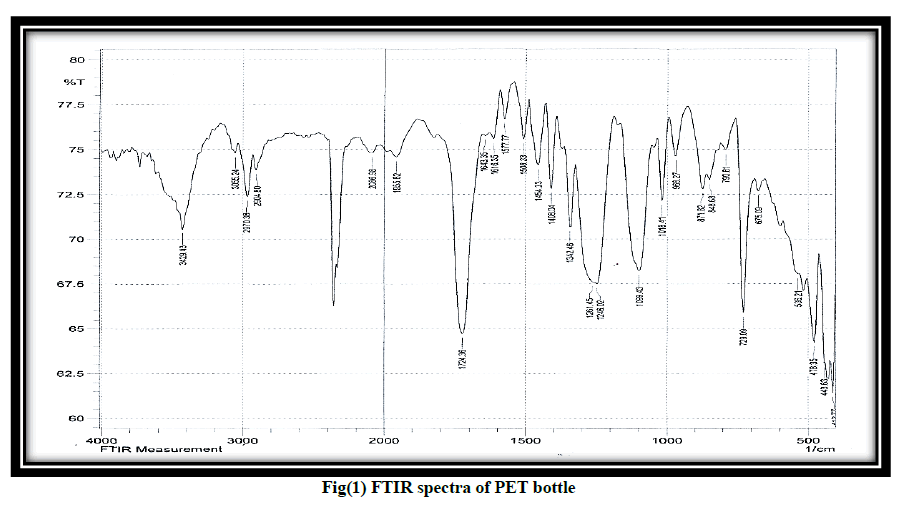 |
| Sawdust wood (S.D.W) obtained from local carpentry and wood -working processes with average lengths about 5- 20mm and thickness about 1.05 mm was used. |
Preparation method |
Recycling PET samples (RPET) |
| In order to prepare RPET samples, 50 empty pre-used transparent water plastic PET bottles were collected ,in order to be used for the process of plastic recycling that can be reused in different useful fields of engineering construction . All the commercial sticker labels were pealed and removed from the bottles and then were cleaned and dried. Also the neck and the base of each bottle were excluded were not used. Each bottle (of net weight of 5.55gm) was shredded to small pieces by an ordinary scissors; each piece is approximately of 30*20mm in dimension and recycled at different melting temperatures, with best results obtained at 180°C , 200°C, 220°C and 240°C. The RPET samples weremelted by placing them in a pot and heating the contents at 180°C for 10 minutes . For The first sample same process was repeated for different intervals of time (20,30,40,50 and 60 minutes). The melted contents then were pouredin containers for measuring physical test (thermal conductivity and water absorption) , They were left for 24 hours to have the solid sample, were then taken out of the containers .The whole process was repeated for RPET samples atheating temperatures of 200°C, 220°Cand240°C respectively. It was noticed that the best results were obtained at melting time of 50 minutes. |
Preparation of RPET/S.D.W composites |
| It is necessary to remove the residual moisture in the sawdust wood which would greatly affect the properties of the composite. For this reason, the sawdust wood was dried in an oven at 100 ± 2°C for 24 hours . The same processes of melting mentioned above were repeated and except that at 15 minutes from the end of the melting process, a different weight percentage (10%,20%,30%,40%,50% and 60%) of sawdust wood) was added each time to the pot and well mixed with the contents in order to obtain a homogeneous mixture .Weight percentage 30% of sawdust wood was chosen to obtain optimum conditions . The melted contents then were poured in standard containers for measuring the thermal conductivity and water absorption. |
PHYSICAL TEST |
1-Thermal conductivity test |
| The prepared samples(A,B,C,D,E,F,G,H) for thermal conductivity test are shown in figure (2) and (3) with diameter 88mm and thickness about 5.7mm. Lee's .disc method was used to measure the thermal conductivity (K)is defined at the heat current per unit area, which is perpendicular to the flow, and per unit temperature gradient by using the following equations (1) and(2) |
H=m c dT/dt(1) |
k=Hb/A(T1-T2) (2) |
| Where H heat current , m = is the mass of the lower disc (kgm),c is the specific heat for the upper and lower discs , A = the area of the specimen (ÃÂÿ r2) (m2) , r is the radius of the specimen, and b is the specimen thickness (m) [14]. |
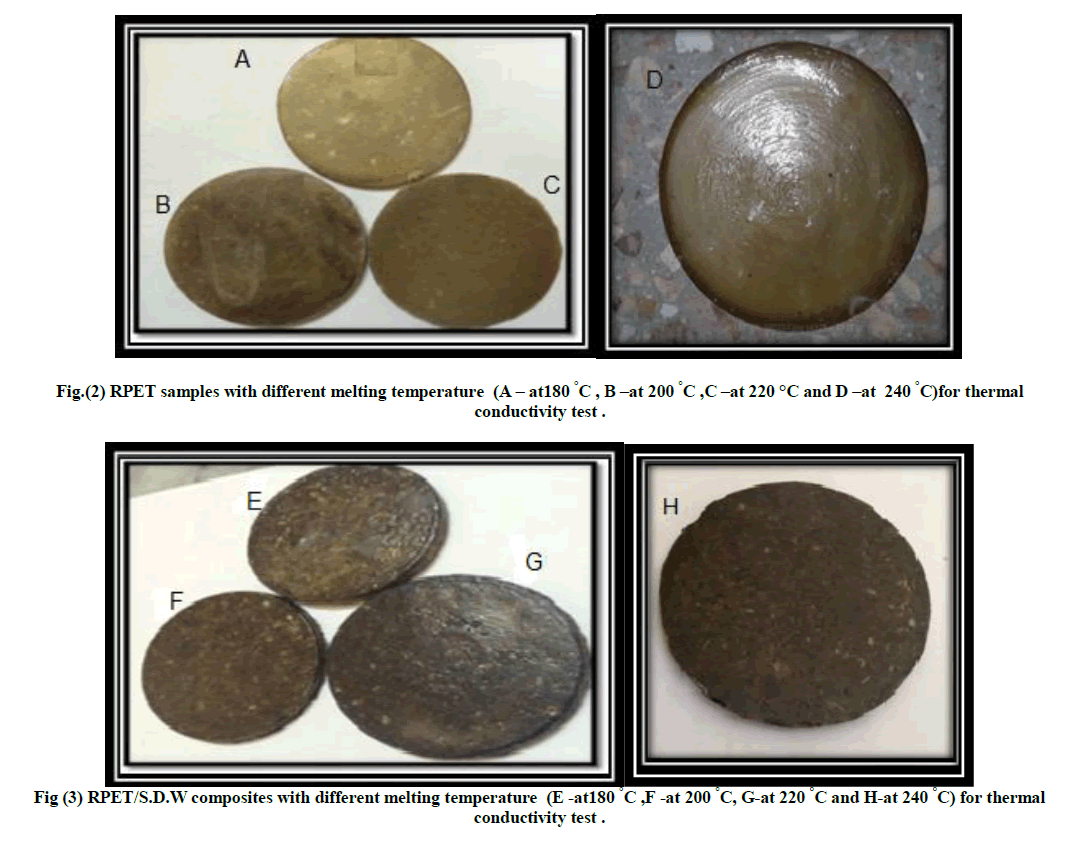 |
2-Water absorption test |
| Eightsamples prepared for RPET and RPET/S.D.W composites (I,J,K,L,M,N,O,P)according to ASTM-d570are shown in figure(4) and (5) , were immersed in distilled water for 92 days. |
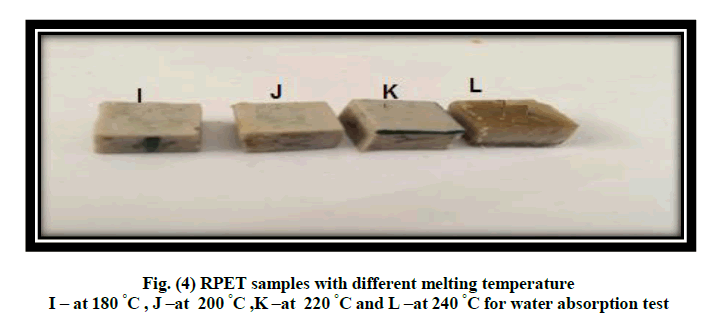 |
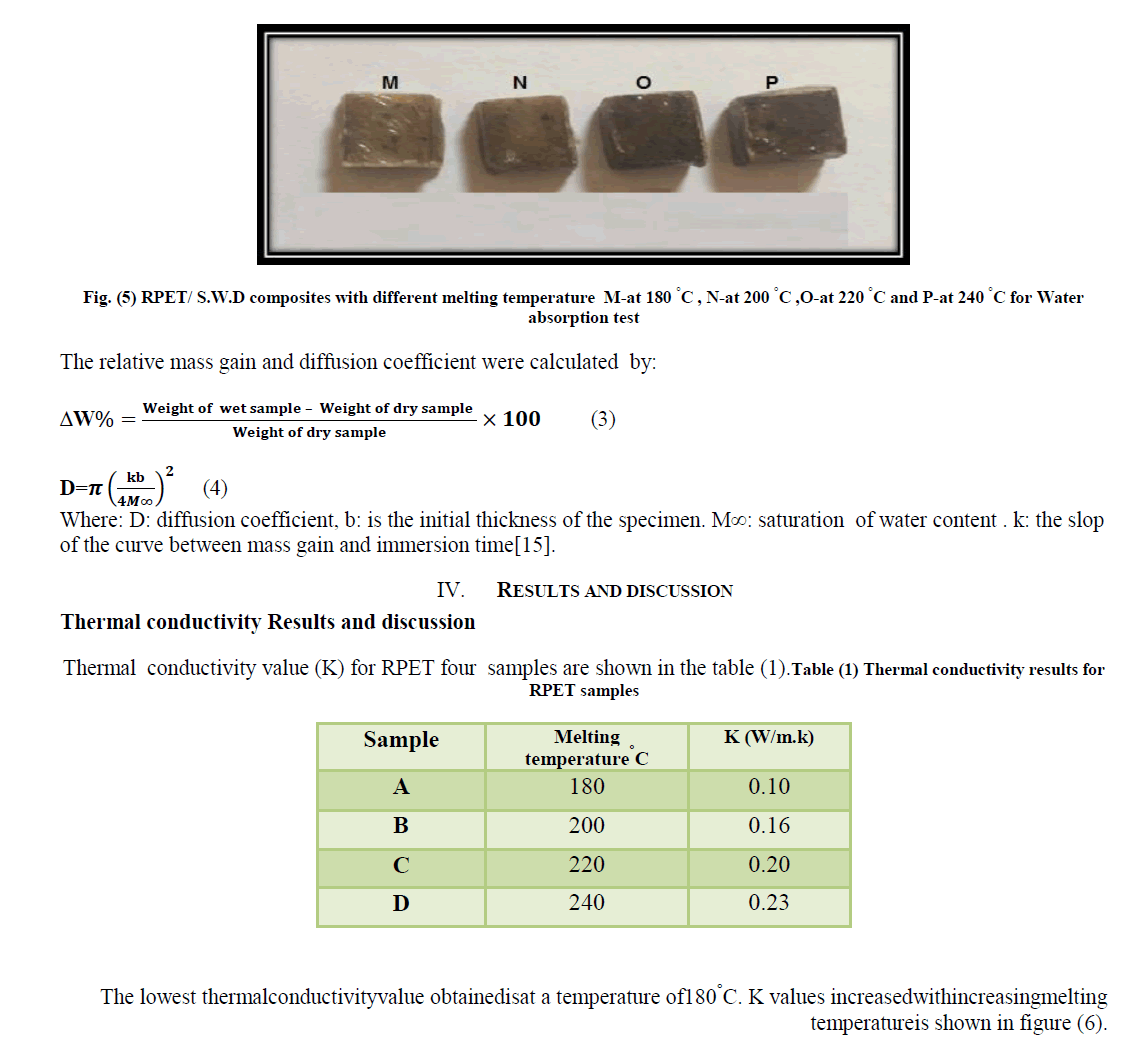 |
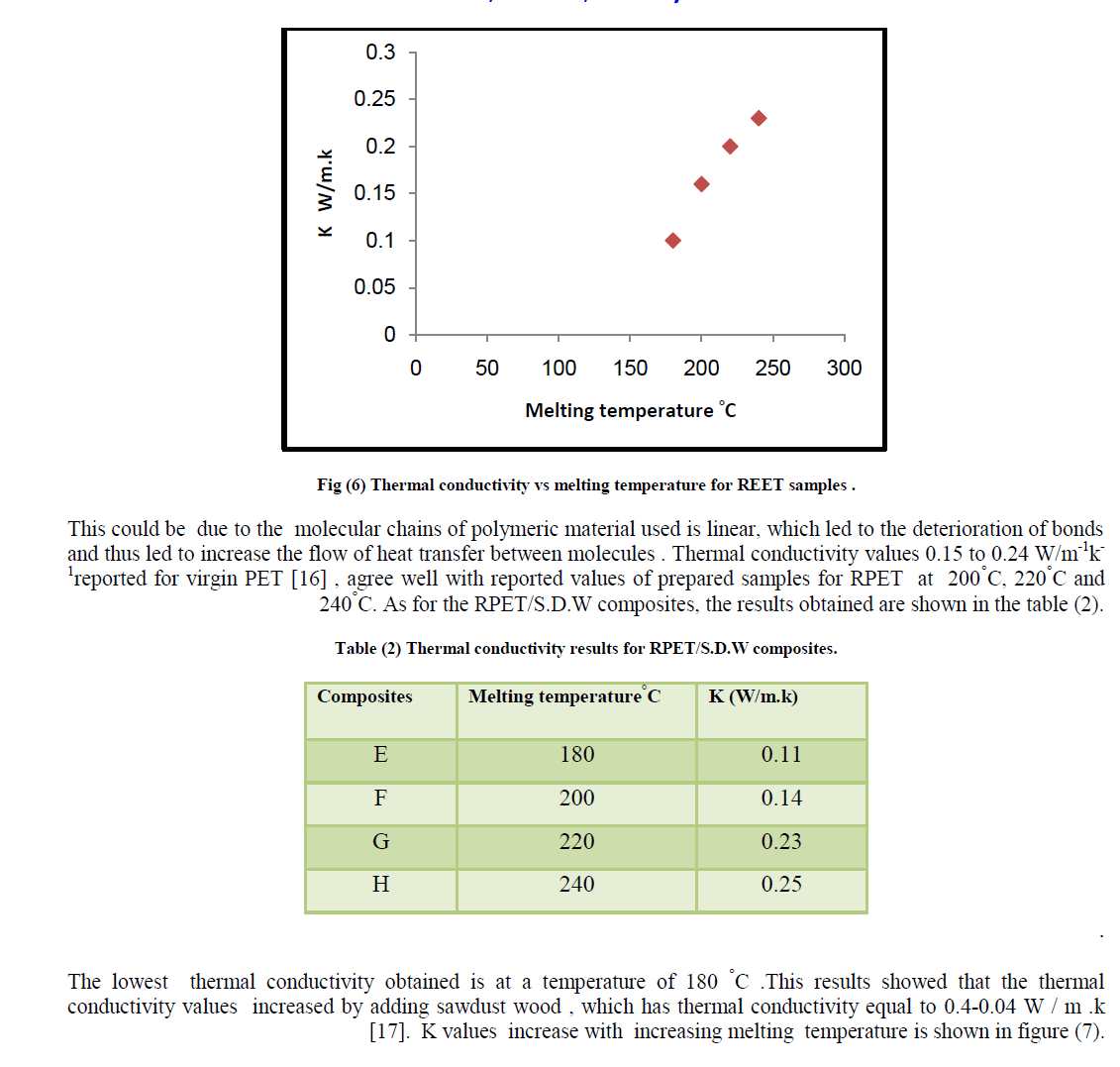 |
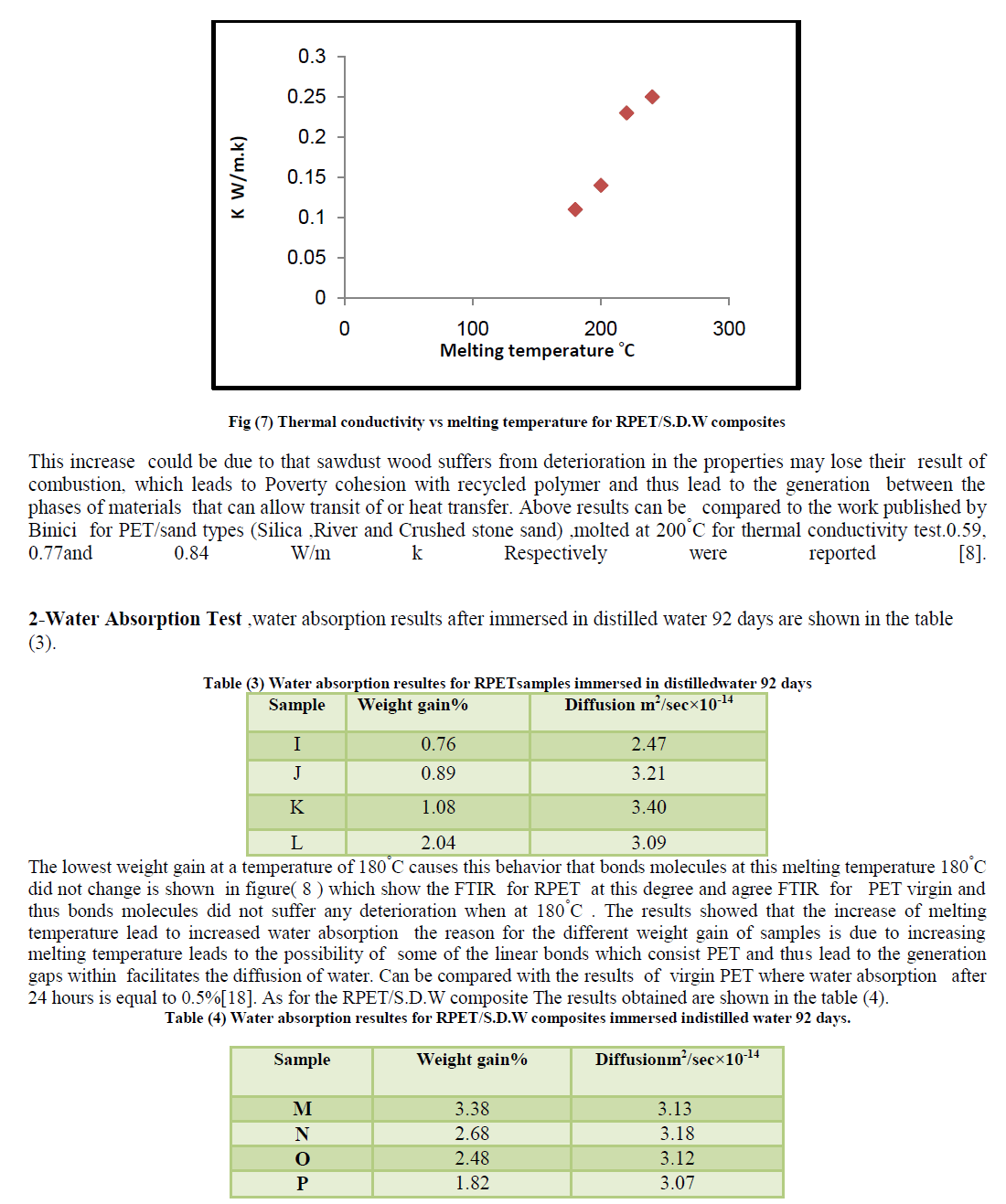 |
| The results reported that lowest weight gain at melting temperature of 240°C, Because of the high temperatures affect the sawdust wood cause lose properties ,as result of the Burn .Water absorption increasing When less melting temperatures. When the content of the increase sawdust wood , and a number of groups -OH free is to contain more than cellulose and hemicellulose into fiber responsible for increasing the water absorption. The results can be compared with those results obtained by the Rahman use where the waste PET /S.D.W composites and recycling by flat-pressed wood plastic The result agree well with results Weight gain obtained 3.65% ,Found WA were measured after 24 hours of immersion in water [7]. |
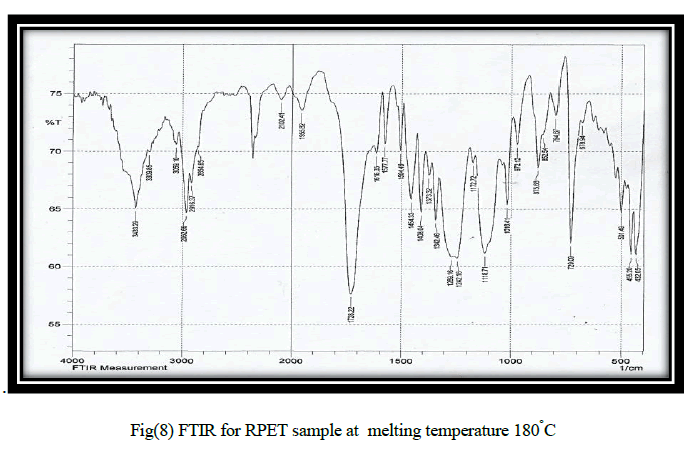 |
CONCLUSION |
| Sample A for RPET showslowest value of thermal Conductivity at a temperature of 180 °C 0.10 W/m.kand for the RPET/S.D.W composites the lowest result obtained at 180°C for sample E equal 0.11 W/m.k. The sample I for RPET is the best in terms of water absorption at melting temperature of 180 °C and the sample P forRPET/S.D.W composites the Lowest water absorption at melting temperature 240°C equal 1.82 . Conclusion when adding sawdust wood (S.D.W) to RPET increase the water absorption of the material because the sawdust wood containing cellulose responsible for water absorption. |
References |
|